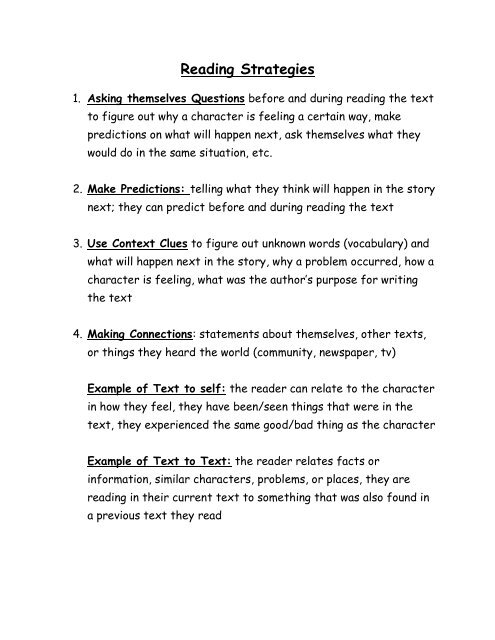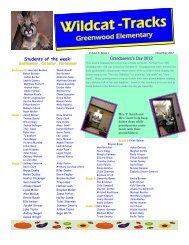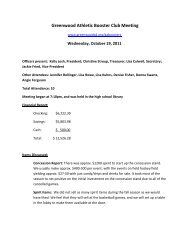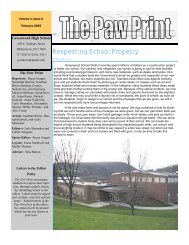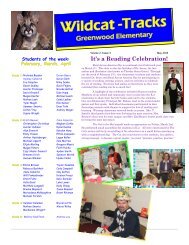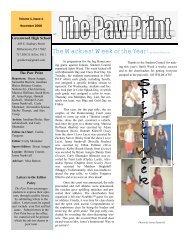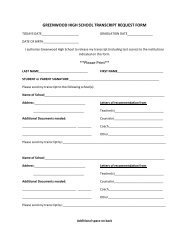Reading Strategies & Comprehension Skills - Greenwood School ...
Reading Strategies & Comprehension Skills - Greenwood School ...
Reading Strategies & Comprehension Skills - Greenwood School ...
You also want an ePaper? Increase the reach of your titles
YUMPU automatically turns print PDFs into web optimized ePapers that Google loves.
<strong>Reading</strong> <strong>Strategies</strong><br />
1. Asking themselves Questions before and during reading the text<br />
to figure out why a character is feeling a certain way, make<br />
predictions on what will happen next, ask themselves what they<br />
would do in the same situation, etc.<br />
2. Make Predictions: telling what they think will happen in the story<br />
next; they can predict before and during reading the text<br />
3. Use Context Clues to figure out unknown words (vocabulary) and<br />
what will happen next in the story, why a problem occurred, how a<br />
character is feeling, what was the author’s purpose for writing<br />
the text<br />
4. Making Connections: statements about themselves, other texts,<br />
or things they heard the world (community, newspaper, tv)<br />
Example of Text to self: the reader can relate to the character<br />
in how they feel, they have been/seen things that were in the<br />
text, they experienced the same good/bad thing as the character<br />
Example of Text to Text: the reader relates facts or<br />
information, similar characters, problems, or places, they are<br />
reading in their current text to something that was also found in<br />
a previous text they read
Example of Text to World: the reader relates something or an<br />
event that has occurred in the world to their own state, city,<br />
town, home, or school.<br />
5. Re-reading paragraphs, pages, or chapters to CLARIFY any<br />
information they didn’t understand or that they forget what they<br />
just read<br />
6. Summarize: telling someone what you just read (by paragraph,<br />
page, chapter) by picking out the most important events/details<br />
a. Oral summaries are supposed to be short<br />
b. Written summaries should be short too, about a paragraph in<br />
length (5-6 sentences)<br />
7. Retelling: telling someone what you just read, BUT you include<br />
many details from the text<br />
a. Think of sitting around a campfire ‘telling stories’. You don’t<br />
want to summarize the stories; you want to tell all the juicy<br />
details by elaborating and being very descriptive.<br />
8. Decoding an Unknown Word<br />
a. Finger tap out the sounds you know<br />
b. Start with the first sound then word your way through the<br />
rest of the word<br />
c. Look for smaller words inside the bigger word<br />
d. Look for vowel combinations, prefixes, or suffixes (-ed, -s,<br />
-ing, -ous, con, re, dis, non, in, un, -unk, -ank, -ay, -ai, -or, -ur,
-er, -ir, ow, ou, ar, au, etc.<br />
e. When you see a vowel, try saying the short vowel sound first,<br />
then try the long vowel sound<br />
9. Visualizing: the reader makes a picture in their mind as they are<br />
reading to help them understand the text and be more engaged<br />
with the text.<br />
10. Inferencing the reader uses the clues from the text as well<br />
as their background knowledge (what they already know about the<br />
situation or problem) to decide on some of the following:<br />
a. How a character feels<br />
b. Why an event/problem happened<br />
c. Why a character said or did what they did<br />
d. What will happen next<br />
*Inferences are made on single events<br />
11. Drawing Conclusions: very similar to making Inferences except<br />
that a conclusion is based upon an entire chapter or book that<br />
relates to a general question<br />
a. Example: After reading this chapter, what conclusion can you<br />
make about how water is important to all kinds of life
<strong>Reading</strong> <strong>Comprehension</strong> <strong>Skills</strong><br />
Text Structures (#1-6):<br />
1. Cause & Effect<br />
a. Cause: why something happened<br />
b. Effect: what happened<br />
c. Key words: because, so, as a result, since, due to, thus,<br />
nevertheless, therefore, and<br />
d. Sometimes the author does not use they key words in the<br />
reading, but there are separate sentences that each have<br />
the cause and effect<br />
2. Sequencing: ordering events, person’s time line, how something<br />
is made/fixed, etc.<br />
a. Key words: first, then, next, after, after that, during, while,<br />
later on, finally, at the end, in the beginning, in the middle,<br />
etc.<br />
3. Compare & Contrast<br />
a. Compare: see how things are the same<br />
b. Contrast: see how things are different<br />
c. Always great to use a Venn Diagram to do this skill<br />
4. Problem/Solution<br />
5. Main Idea & Details
6. Descriptive: the text (non-fiction) provides descriptions of<br />
the subject discussed throughout the book<br />
7. Author’s Purpose: the reader thinks about the information or<br />
story they read to decide why the author wrote the book.<br />
Students need to provide evidence from the text (specific<br />
details) to support which reason the author wrote the text.<br />
Think of PIE: Persuade, Inform, or Entertain<br />
8. Author’s Viewpoint: the reader thinks about the information<br />
presented in the text (i.e. article) and tries to figure out what<br />
side of the situation or problem is the author on. Students try<br />
to figure out if the author has a BIAS for one side of the<br />
problem.<br />
a. Problem: Should wolves be kept to certain areas of the US<br />
or can they be allowed to roam anywhere<br />
b. Side A (Farmers/Ranchers): They feel wolves need to be<br />
kept to certain areas of US because if wolves get to close<br />
to their farms, they will loose cattle, crops, etc.<br />
c. Side B (Wolves Activitists): They feel wolves could be<br />
integrated into other areas of the US because some<br />
organizations would pay the famers for crop/animals damage
9. Author’s Message or Theme: at the end of the text the reader<br />
is supposed to think about what lesson they were supposed to<br />
learn from the characters, problem in the story, or situations<br />
not to get themselves into in real life.<br />
a. This is not stated in the text, the student needs to use the<br />
clues and events in the text to decide<br />
10. Story Elements: these parts are always found in a fiction<br />
text<br />
a. Characters (main & secondary characters)<br />
b. Setting (where, when)<br />
c. Plot (main events from beginning, middle, end…this include<br />
the problem, solution, rising action, climax)<br />
d. Problem<br />
e. Solution: how problem was solved<br />
f. Rising Action: the events that lead to the Climax<br />
g. Climax: the most interesting, nail-biting, hanging on the<br />
edge of your seat moment in the text<br />
11. Character Traits: the reader using clues from the text to<br />
figure out adjectives to describe the character<br />
a. Brave, courageous, loyal<br />
b. Terrible, unfriendly, disloyal<br />
c. Entertaining, interesting, funny<br />
d. Spontaneous, fast-thinker, creative<br />
WORDS LIKE COOL, AWESOME, NICE, KIND, BAD ARE<br />
NOT ACCEPTABLE!!!!
12. Fact vs. Opinion<br />
13. Non-Fiction Text Features<br />
a. Illustrations, Real Photographs, Pictures<br />
b. Captions: the sentences underneath the photographs that<br />
describe the pictures<br />
c. Diagrams (with labels), Graphs, Tables, Flow Charts<br />
d. Title<br />
e. Headings: the bold faced words to section off chapters in<br />
the text<br />
f. Subtitle, Subheading<br />
g. Table of Contents: gives the name of chapter and page<br />
number they are found on in the text<br />
h. Glossary<br />
i. Index<br />
j. Bold Print or Italicized Print Words<br />
k. Information boxes or Sidebars


